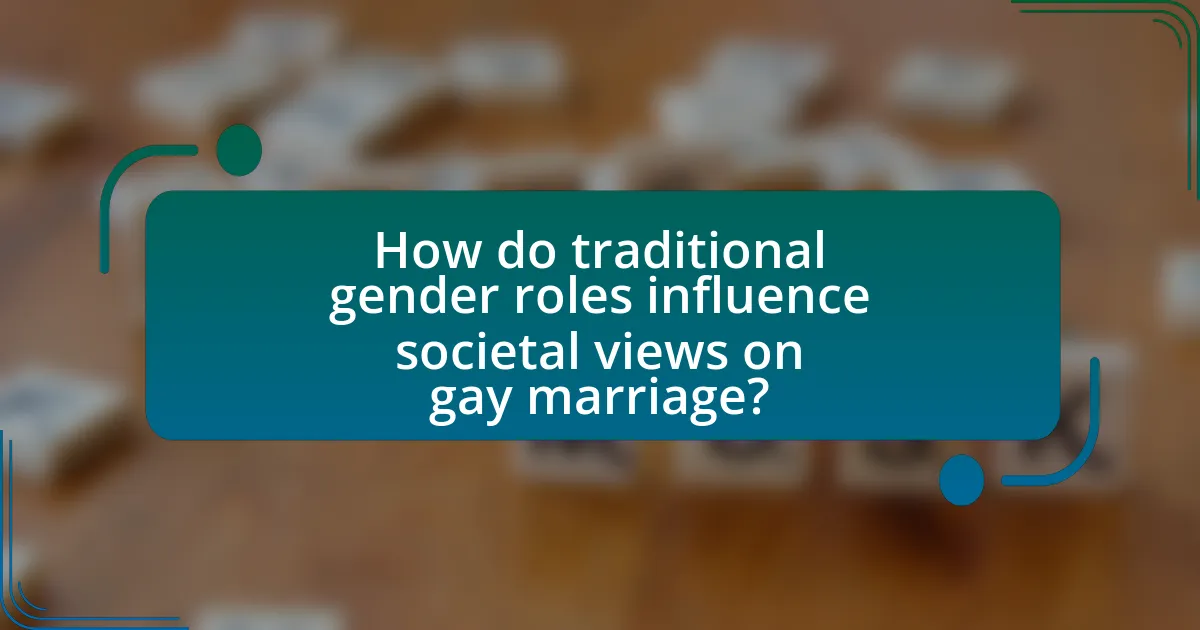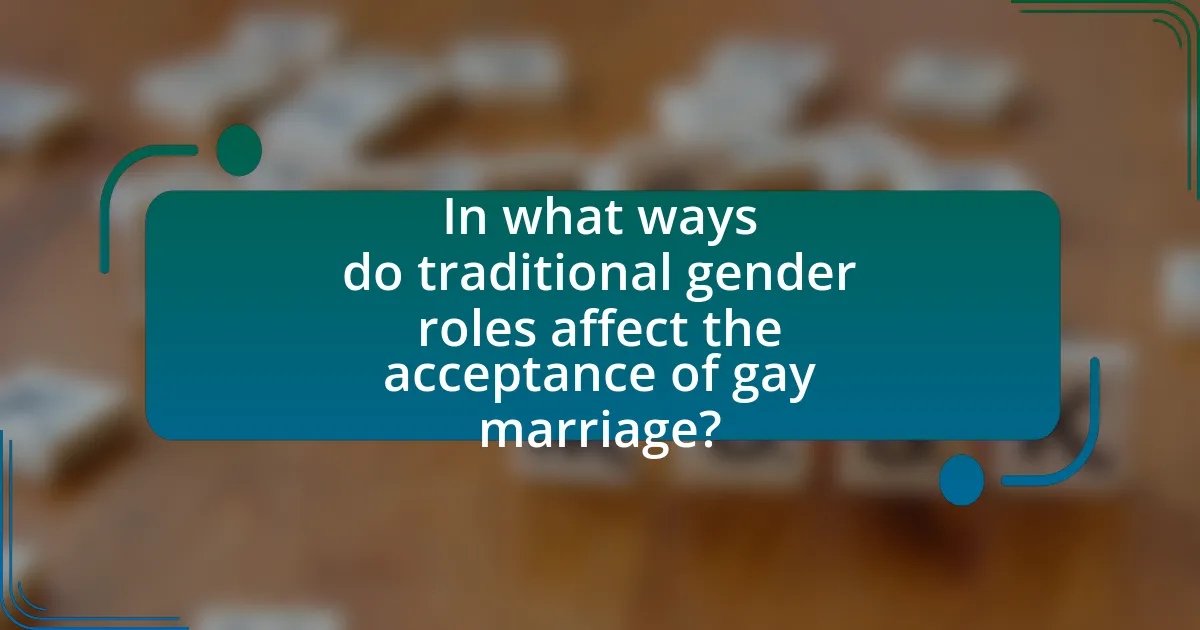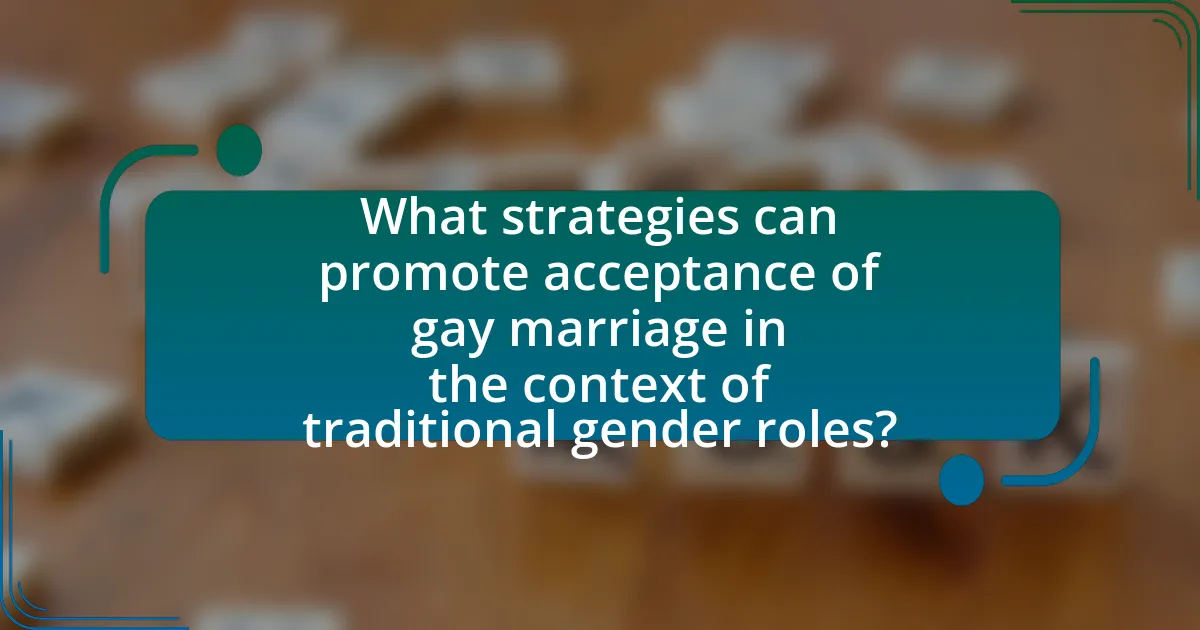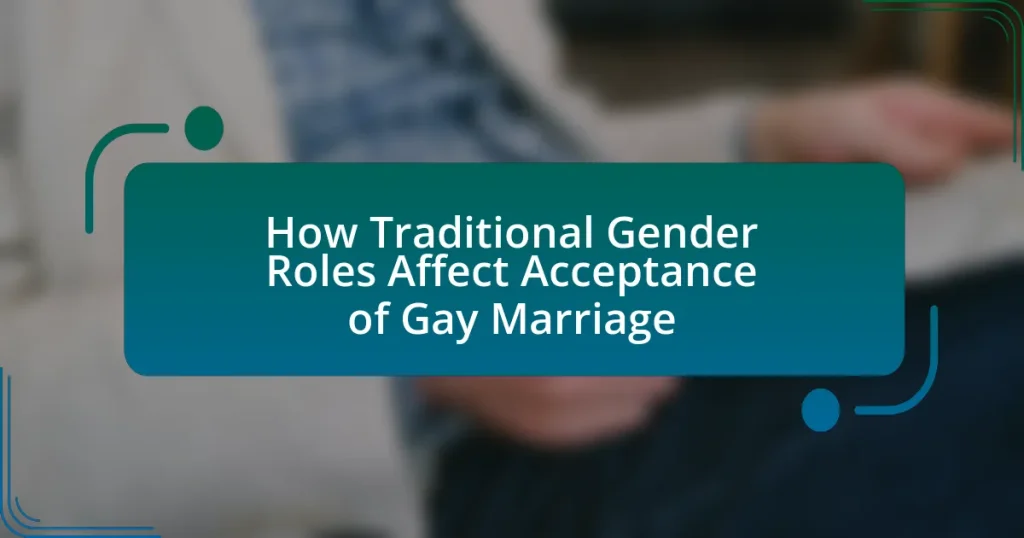The article examines how traditional gender roles influence societal views on gay marriage, highlighting the reinforcement of heteronormative expectations that prioritize heterosexual relationships. It defines traditional gender roles as societal norms dictating behaviors and responsibilities based on gender, which can marginalize same-sex marriages. The article explores the cultural variations of these roles, historical factors shaping them, and their impact on public opinion, legal recognition, and internalized homophobia among LGBTQ+ individuals. Additionally, it discusses strategies for promoting acceptance of gay marriage through education, media representation, and community initiatives, emphasizing the role of allies in advocating for LGBTQ+ rights.

How do traditional gender roles influence societal views on gay marriage?
Traditional gender roles significantly influence societal views on gay marriage by reinforcing heteronormative expectations that prioritize heterosexual relationships as the norm. These roles often dictate that men and women should adhere to specific behaviors and responsibilities, which can marginalize non-traditional relationships, including same-sex marriages. For instance, a study published in the Journal of Marriage and Family found that individuals who strongly endorse traditional gender roles are less likely to support gay marriage, reflecting a broader societal resistance to changing norms. This resistance is rooted in the belief that marriage should only exist between a man and a woman, thereby impacting legislative and social acceptance of gay marriage.
What are traditional gender roles and how are they defined?
Traditional gender roles are societal norms that dictate the behaviors, responsibilities, and expectations associated with being male or female. These roles are typically defined by cultural, historical, and social contexts, where men are often expected to be providers and protectors, while women are seen as caregivers and homemakers. For example, in many cultures, men are encouraged to pursue careers and display assertiveness, whereas women are often socialized to prioritize family and nurturing roles. Research indicates that these roles can influence attitudes toward various social issues, including the acceptance of gay marriage, as rigid adherence to traditional roles may lead to resistance against non-conforming relationships.
How do traditional gender roles vary across different cultures?
Traditional gender roles vary significantly across different cultures, influencing societal expectations and behaviors regarding masculinity and femininity. For instance, in many Western cultures, traditional gender roles often emphasize individualism and equality, allowing for more fluid expressions of gender identity. In contrast, many Middle Eastern and South Asian cultures uphold rigid gender roles, where men are typically seen as providers and women as caretakers, often limiting opportunities for gender expression and reinforcing patriarchal structures. Research indicates that societies with more egalitarian gender roles tend to show higher acceptance of diverse sexual orientations, including gay marriage, as seen in Scandinavian countries where gender equality is prioritized. This correlation suggests that the rigidity or flexibility of gender roles within a culture can directly impact the acceptance of LGBTQ+ rights and relationships.
What historical factors have shaped traditional gender roles?
Traditional gender roles have been shaped by various historical factors, including economic structures, religious beliefs, and social norms. For instance, during the agrarian society, labor division based on gender was prevalent, with men typically engaging in physical labor and women managing domestic responsibilities. This division was reinforced by religious doctrines, such as those found in Christianity and Islam, which often prescribed specific roles for men and women. Additionally, the Industrial Revolution shifted economic roles but did not significantly alter gender expectations, as men continued to be viewed as breadwinners while women were relegated to homemaking. These historical contexts have entrenched traditional gender roles, influencing contemporary attitudes towards gender and, by extension, the acceptance of gay marriage.
Why do traditional gender roles create resistance to gay marriage?
Traditional gender roles create resistance to gay marriage by reinforcing the belief that marriage should only exist between a man and a woman, based on historical norms of masculinity and femininity. These roles dictate specific behaviors and expectations for men and women, leading to societal discomfort with relationships that do not conform to these binaries. Research indicates that societies with rigid gender norms often exhibit higher levels of homophobia, as deviations from traditional roles are viewed as threats to social order. For instance, a study published in the Journal of Marriage and Family found that individuals who strongly adhere to traditional gender norms are less likely to support same-sex marriage, highlighting the direct correlation between these norms and resistance to LGBTQ+ rights.
How do stereotypes associated with gender roles affect perceptions of gay relationships?
Stereotypes associated with gender roles significantly influence perceptions of gay relationships by reinforcing traditional expectations of masculinity and femininity. These stereotypes often lead to the belief that gay relationships deviate from normative gender behaviors, resulting in societal stigma and discrimination. For instance, research indicates that individuals who adhere strongly to traditional gender norms are more likely to hold negative attitudes toward gay relationships, as they perceive them as a threat to established gender hierarchies (Herek, 2000). This perception can hinder acceptance and support for gay marriage, as societal acceptance is often contingent upon conformity to traditional gender roles.
What role does religion play in reinforcing traditional gender roles and attitudes towards gay marriage?
Religion plays a significant role in reinforcing traditional gender roles and shaping attitudes towards gay marriage by promoting specific doctrines that often emphasize heterosexual norms and gender binaries. Many religious teachings advocate for distinct roles for men and women, which can lead to the perception that deviations from these roles, such as same-sex relationships, are unacceptable. For instance, various religious texts, including the Bible and the Quran, contain passages that are interpreted as condemning homosexuality, thereby influencing followers’ views on gay marriage. Research indicates that individuals who identify strongly with conservative religious beliefs are less likely to support gay marriage, as seen in studies conducted by the Pew Research Center, which found that 70% of white evangelical Protestants opposed same-sex marriage in 2020. This correlation illustrates how religious beliefs can perpetuate traditional gender roles and foster negative attitudes towards LGBTQ+ rights.

In what ways do traditional gender roles affect the acceptance of gay marriage?
Traditional gender roles significantly hinder the acceptance of gay marriage by reinforcing heteronormative expectations and stigmatizing non-conforming relationships. These roles dictate that men and women should adhere to specific behaviors and relationships, often marginalizing those who deviate from these norms. For instance, studies show that societies with rigid gender norms tend to exhibit higher levels of homophobia, which directly correlates with lower acceptance rates of gay marriage. Research by the Pew Research Center indicates that in countries where traditional gender roles are prevalent, support for same-sex marriage is often below 30%. This demonstrates that entrenched beliefs about masculinity and femininity create barriers to recognizing and legitimizing same-sex unions.
How do gender expectations impact the legal recognition of gay marriage?
Gender expectations significantly impact the legal recognition of gay marriage by reinforcing traditional norms that often oppose same-sex unions. These societal norms dictate that marriage should be between a man and a woman, which has historically influenced legislation and public policy. For instance, in many jurisdictions, the legal framework surrounding marriage has been shaped by these expectations, leading to resistance against recognizing gay marriage. Research indicates that states with stronger adherence to traditional gender roles tend to have lower rates of acceptance for gay marriage, as seen in studies conducted by the Williams Institute, which highlight the correlation between cultural attitudes and legal outcomes.
What are the implications of gender norms on marriage equality legislation?
Gender norms significantly influence marriage equality legislation by shaping societal attitudes towards same-sex relationships. Traditional gender roles often dictate that marriage is a union between a man and a woman, which can lead to resistance against legal recognition of same-sex marriages. For instance, studies have shown that societies with rigid gender norms tend to have lower acceptance rates for LGBTQ+ rights, including marriage equality. According to a 2019 report by the Pew Research Center, countries with more progressive views on gender roles are more likely to support same-sex marriage legislation, highlighting the correlation between gender norms and legal reforms. Thus, the implications of gender norms on marriage equality legislation are profound, as they can either hinder or promote the acceptance and legal recognition of same-sex marriages based on societal beliefs about gender and relationships.
How do traditional views on masculinity and femininity influence public opinion on gay marriage?
Traditional views on masculinity and femininity significantly influence public opinion on gay marriage by reinforcing heteronormative standards that often marginalize non-traditional relationships. These views typically associate masculinity with dominance and heterosexuality, while femininity is linked to nurturing and support within traditional family structures. Consequently, individuals who adhere to these gender norms may perceive gay marriage as a threat to established social order and family values. Research indicates that societies with rigid gender roles tend to exhibit lower acceptance of LGBTQ+ rights, including gay marriage, as seen in studies conducted by the Pew Research Center, which found that acceptance varies significantly based on cultural attitudes towards gender.
What are the psychological effects of traditional gender roles on LGBTQ+ individuals?
Traditional gender roles negatively impact the psychological well-being of LGBTQ+ individuals by fostering internalized stigma, anxiety, and depression. These individuals often experience pressure to conform to societal expectations that do not align with their identities, leading to feelings of inadequacy and isolation. Research indicates that LGBTQ+ individuals who internalize traditional gender norms are more likely to report higher levels of psychological distress. For instance, a study published in the Journal of Homosexuality found that adherence to rigid gender roles correlates with increased rates of mental health issues among LGBTQ+ populations. This internal conflict can hinder their ability to form healthy relationships and contribute to lower self-esteem, ultimately affecting their overall quality of life.
How do traditional gender roles contribute to internalized homophobia?
Traditional gender roles contribute to internalized homophobia by enforcing rigid expectations about masculinity and femininity, which can lead individuals to reject their own sexual orientation if it does not align with these norms. For instance, societal pressures dictate that men should be dominant and heterosexual, while women should be nurturing and feminine. When individuals identify as LGBTQ+, they may internalize the belief that their identity is deviant or shameful, resulting in feelings of self-hatred or inadequacy. Research indicates that individuals who strongly adhere to traditional gender norms are more likely to experience internalized homophobia, as these norms create a framework that stigmatizes non-heteronormative identities. This internal conflict can hinder acceptance of both oneself and broader LGBTQ+ rights, including gay marriage.
What support systems can help LGBTQ+ individuals navigate traditional gender expectations?
Support systems that can help LGBTQ+ individuals navigate traditional gender expectations include community organizations, mental health services, and educational programs. Community organizations, such as LGBTQ+ centers, provide safe spaces for individuals to connect, share experiences, and access resources tailored to their needs. Mental health services, particularly those specializing in LGBTQ+ issues, offer counseling and support to help individuals cope with societal pressures and internal conflicts related to gender expectations. Educational programs aimed at promoting awareness and understanding of gender diversity can also empower LGBTQ+ individuals by fostering acceptance and challenging traditional norms. Research indicates that supportive environments significantly improve mental health outcomes for LGBTQ+ individuals, highlighting the importance of these systems in navigating traditional gender expectations.

What strategies can promote acceptance of gay marriage in the context of traditional gender roles?
Promoting acceptance of gay marriage within traditional gender roles can be effectively achieved through education, visibility, and dialogue. Education initiatives that challenge stereotypes and provide accurate information about LGBTQ+ relationships can help reshape perceptions. For instance, incorporating LGBTQ+ topics into school curricula has been shown to foster understanding and reduce prejudice among students. Visibility of gay couples in media and public life can normalize these relationships, making them more relatable and accepted. Furthermore, open dialogues that involve both supporters and opponents of gay marriage can create a platform for discussing misconceptions and fostering empathy. Research indicates that personal connections to LGBTQ+ individuals significantly increase support for gay marriage, highlighting the importance of shared experiences in changing attitudes.
How can education challenge traditional gender roles and promote inclusivity?
Education can challenge traditional gender roles and promote inclusivity by integrating diverse perspectives and fostering critical thinking. By incorporating curricula that highlight gender diversity, historical contributions of various gender identities, and the importance of equality, educational institutions can reshape students’ understanding of gender roles. Research indicates that inclusive education leads to greater acceptance of LGBTQ+ individuals; for instance, a study published in the Journal of Homosexuality found that students exposed to inclusive curricula were more likely to support gay marriage. This evidence demonstrates that education serves as a powerful tool in dismantling stereotypes and promoting a more inclusive society.
What role do media representations play in reshaping perceptions of gender and sexuality?
Media representations significantly influence the reshaping of perceptions regarding gender and sexuality by providing narratives that challenge traditional norms. These representations, through various forms such as television, film, and social media, often depict diverse gender identities and sexual orientations, thereby normalizing experiences that deviate from conventional expectations. For instance, studies have shown that increased visibility of LGBTQ+ characters in mainstream media correlates with greater acceptance of gay marriage among audiences, as evidenced by research from the Williams Institute, which found that exposure to positive portrayals of same-sex relationships can reduce prejudice and foster understanding. Thus, media serves as a powerful tool in altering societal attitudes towards gender and sexuality by promoting inclusivity and challenging stereotypes.
How can community initiatives foster dialogue around gender roles and gay marriage acceptance?
Community initiatives can foster dialogue around gender roles and gay marriage acceptance by creating inclusive spaces for discussion and education. These initiatives often organize workshops, forums, and events that encourage open conversations about the evolving nature of gender roles and the importance of acceptance in diverse relationships. For instance, studies show that community-led discussions can significantly reduce prejudice; a 2019 report by the Williams Institute found that increased dialogue in community settings correlates with higher acceptance rates of same-sex marriage. By facilitating these interactions, community initiatives help challenge traditional norms and promote understanding, ultimately leading to greater societal acceptance of gay marriage.
What practical steps can individuals take to advocate for gay marriage acceptance?
Individuals can advocate for gay marriage acceptance by engaging in open conversations about LGBTQ+ rights, educating themselves and others on the importance of marriage equality, and participating in local advocacy groups. Engaging in discussions helps to challenge traditional gender roles and stereotypes that may hinder acceptance. Education can include sharing factual information about the legal and social benefits of marriage equality, which can help dispel myths and misconceptions. Participation in advocacy groups, such as local LGBTQ+ organizations, can amplify voices and efforts toward policy change. According to a 2020 Gallup poll, 67% of Americans support same-sex marriage, indicating a growing acceptance that individuals can further promote through active involvement and dialogue.
How can allies support LGBTQ+ rights in the face of traditional gender norms?
Allies can support LGBTQ+ rights by actively challenging traditional gender norms and advocating for inclusivity. This can be achieved through education, promoting awareness of LGBTQ+ issues, and standing against discriminatory practices. For instance, research indicates that individuals who engage in conversations about gender diversity and LGBTQ+ rights contribute to a more accepting environment, as seen in studies by the Human Rights Campaign, which highlight that supportive allies can significantly influence public attitudes towards LGBTQ+ individuals. By participating in pride events, using inclusive language, and supporting policies that protect LGBTQ+ rights, allies reinforce the message that traditional gender norms should not dictate the rights and identities of individuals.
What are effective ways to engage in conversations about gender roles and marriage equality?
Effective ways to engage in conversations about gender roles and marriage equality include fostering open dialogue, using inclusive language, and sharing personal experiences. Open dialogue encourages participants to express their views without fear of judgment, which can lead to deeper understanding. Inclusive language helps to create a safe space for all identities, making discussions more approachable. Sharing personal experiences can humanize the topic, allowing individuals to relate to each other’s perspectives. Research indicates that personal narratives can significantly impact attitudes toward social issues, as evidenced by a study published in the Journal of Social Issues, which found that storytelling can reduce prejudice and promote empathy.


